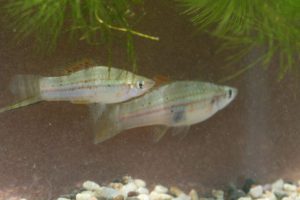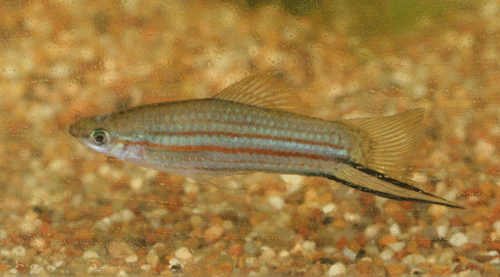Photo: A young, three to four month old, male Xiphophorus alvarezi.
Xiphophorus alvarezi, the Chiapas Swordtail, is a wild swordtail species from, remarkably enough considering its name, the Mexican state of Chiapas. We acquired this species in the auction at the April 2012 Fort Lauderdale convention of the American Livebearer Association (https://livebearers.org/). Here is link to a very fine discussion of this species:
https://www.chicagolivebearer.com/index.php/livebearer-profiles/63-xiphophorus-alvarezi
We presently maintain two breeding colonies of this species. One population has freckles and the other does not. Well not quite; I’m selecting for freckling in one population and no freckling in the other. That’s a work in progress. Both colonies produce the other’s freckling pattern, but as each generation goes by the percentage of the correct type improves. This is natural selection, well…okay, my selection, at work, although part of their “natural” environment is me. They will have to live with that. This, by the way, is an example of what happens to fish under domestication. The breeder’s selection of favorites changes the fish. Not only that, but the fish rapidly genetically adapt to the new conditions, no predators, prepared foods, no seasonality, consistent water conditions, etc. A good example is wild Poecilia latipinna that we collect from nearby streams. The original fish are skittish, hiding from movement. A few generations later they act just like long domesticated commercial mollies, no longer frightened. Why? Because the bolder, less wild fish eat more, mate more, and their genes for calmness increase while genes for fright and fleeing are selected out of the population.
The pictured male at the top is a three to four-month-old from the non-freckled population. He does not show the reddish blush along the back and head of many mature males. His sword will get quite a bit longer. Here are a pair from the freckled population from three years ago when I separated the two populations. Our current freckled breeders have significantly more freckling.



Chuck Breiter says
I hope your commercial business comes back to its former glory. I appreciate your live bearer posts and breeding efforts. i also like the wildlife updates. Please continue to post updates.
I’ve followed you since TFH.
Charles Clapsaddle says
Chuck,
We are working on getting our fish back to pre-storm status. Our cichlids have largely recovered, but livebearers are lagging. I’m working on a number of blogs. Also, we now have a YouTube channel and are beginning to post there.
Charles
Thomas LeGuin says
Do you have the XIPHOPHORUS ALVAREZI, CHIAPAS SWORDTAIL available for sale ? Thanks
Charles Clapsaddle says
Thomas,
We should have some ready about March. Please check back then.
Charles
Sue says
I have had mostly guppies in my tank for years. Last year my daughter bought me a pair of sword tails that only lived for about 9 month but I never seen any off springs. Lately I have noticed one of my guppies that is extremely larger than all the rest of my guppies but my grandson brought it to my attention, this guppy has a sword tail. According to what I have read sword tails and guppies cannot mate so how can this be. I am confused. Any ideas?
Charles Clapsaddle says
Sue, First I’m sorry for the tardy reply. Your message just appeared. There is a sword gene in guppies, in fact a top sword and a bottom sword. A fish with both top sword and bottom sword would be a lyretail.
Charles